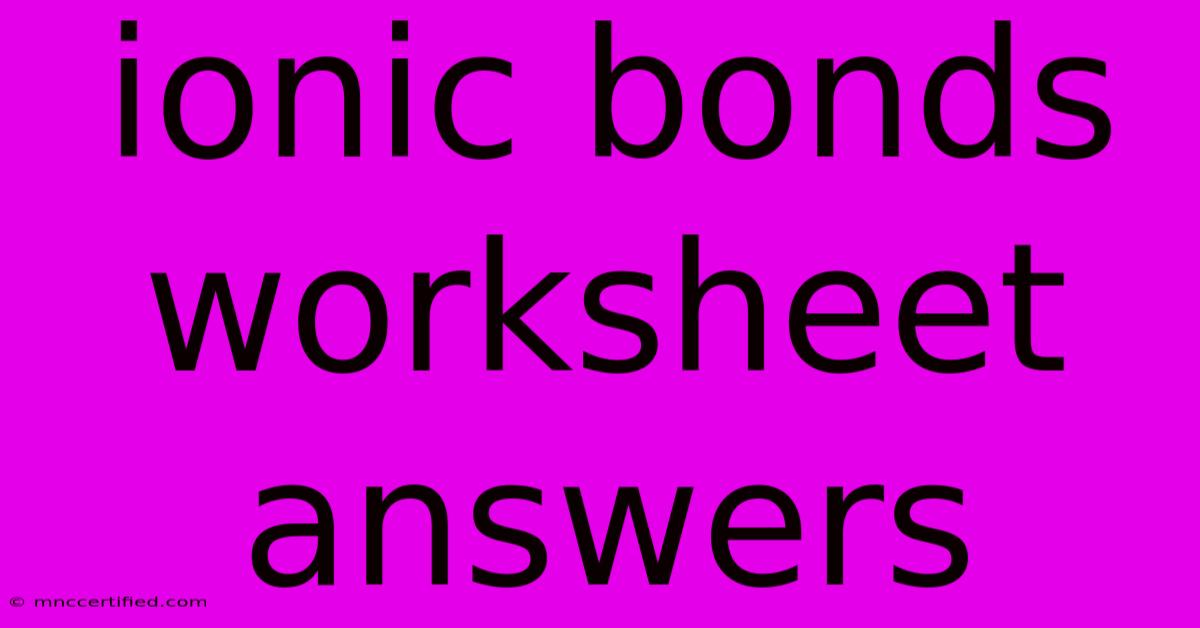Ionic Bonds Worksheet Answers

Table of Contents
Ionic Bonds Worksheet Answers: A Comprehensive Guide
Finding reliable answers to ionic bonds worksheets can be tricky. This comprehensive guide will not only provide you with the answers but also help you understand the underlying concepts of ionic bonding, ensuring you master this crucial chemistry topic. We'll cover key definitions, examples, and problem-solving strategies, making those worksheet answers much more meaningful.
Understanding Ionic Bonds
Before diving into the answers, let's solidify our understanding of ionic bonds. An ionic bond is a type of chemical bond formed through the electrostatic attraction between oppositely charged ions. This occurs when one atom donates electrons to another, creating a positively charged ion (cation) and a negatively charged ion (anion).
Key Concepts to Remember:
- Electronegativity: The ability of an atom to attract electrons towards itself in a chemical bond. A large difference in electronegativity between atoms is crucial for ionic bond formation.
- Metals and Nonmetals: Ionic bonds typically form between metals (which tend to lose electrons) and nonmetals (which tend to gain electrons).
- Octet Rule: Atoms tend to gain, lose, or share electrons to achieve a stable electron configuration, usually with eight electrons in their outermost shell (valence shell). This is known as the octet rule.
Analyzing Ionic Bond Formation: Examples and Practice
Let's look at a classic example: the formation of sodium chloride (NaCl), or common table salt.
- Sodium (Na): A metal with one electron in its outermost shell. It readily loses this electron to achieve a stable octet. This forms a Na⁺ cation.
- Chlorine (Cl): A nonmetal with seven electrons in its outermost shell. It readily gains one electron to achieve a stable octet. This forms a Cl⁻ anion.
The electrostatic attraction between the positively charged Na⁺ ion and the negatively charged Cl⁻ ion forms the ionic bond in NaCl.
Practice: Try to predict the ions formed and the resulting ionic compound for the following pairs of elements:
- Magnesium (Mg) and Oxygen (O)
- Potassium (K) and Bromine (Br)
- Calcium (Ca) and Chlorine (Cl)
(Answers are provided at the end of the article. Try to solve them first to test your understanding!)
Decoding Your Ionic Bonds Worksheet
Now, let's tackle how to approach typical ionic bonds worksheet questions. These often involve:
- Identifying Ions: Determining the charge of ions based on their position in the periodic table.
- Predicting Ionic Compounds: Determining the formula of the ionic compound formed by combining cations and anions, ensuring charge neutrality.
- Naming Ionic Compounds: Learning the rules for naming ionic compounds (e.g., sodium chloride, magnesium oxide).
- Drawing Lewis Dot Structures: Representing the valence electrons and the transfer of electrons during ionic bond formation.
Tips for Success
- Master the Periodic Table: Understanding the periodic table's organization is crucial for determining the number of valence electrons and the charge of ions.
- Practice Regularly: The more you practice, the easier it will become to identify ions, predict formulas, and name ionic compounds.
- Use Online Resources: Numerous online resources, including interactive simulations and tutorials, can help solidify your understanding.
Worksheet Answer Key (Example Problems)
Here are the answers to the practice problems:
- Magnesium (Mg) and Oxygen (O): Mg loses two electrons (Mg²⁺) and Oxygen gains two electrons (O²⁻). The ionic compound formed is MgO (Magnesium Oxide).
- Potassium (K) and Bromine (Br): K loses one electron (K⁺) and Bromine gains one electron (Br⁻). The ionic compound formed is KBr (Potassium Bromide).
- Calcium (Ca) and Chlorine (Cl): Ca loses two electrons (Ca²⁺) and each Chlorine atom gains one electron (Cl⁻). Two Chlorine atoms are needed to balance the charge of one Calcium atom. The ionic compound formed is CaCl₂ (Calcium Chloride).
This guide provides a strong foundation for understanding ionic bonds. Remember, consistent practice and a clear understanding of fundamental concepts are key to mastering this important chemistry topic. Good luck with your worksheets! Don't hesitate to use additional online resources for further clarification and practice problems. Remember to always check your work against your textbook or other reliable sources for accuracy.

Thank you for visiting our website wich cover about Ionic Bonds Worksheet Answers. We hope the information provided has been useful to you. Feel free to contact us if you have any questions or need further assistance. See you next time and dont miss to bookmark.
Featured Posts
-
Ionic Bonds Gizmos Answer Key
Nov 28, 2024
-
Mishal Husain Ends 25 Year Bbc Career
Nov 28, 2024
-
Domestic Violence Bond Amount
Nov 28, 2024
-
Test Call Up For Nathan Smith
Nov 28, 2024
-
Putnam Investments Stock Price
Nov 28, 2024